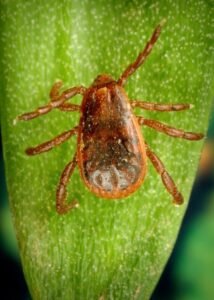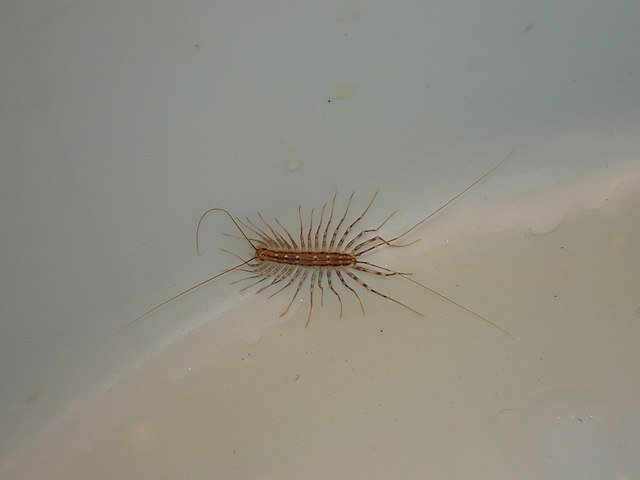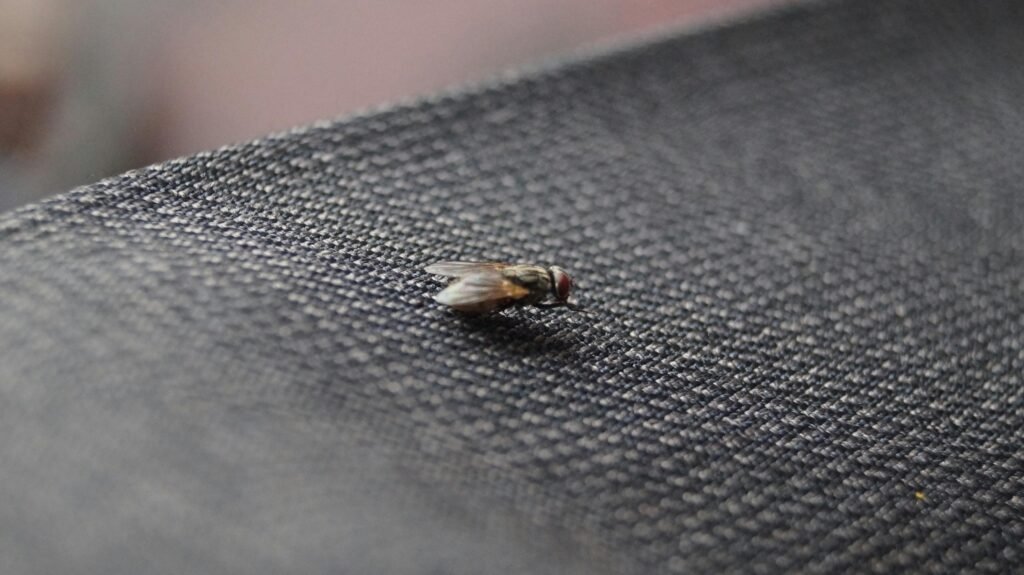Brown Dog Tick (Rhipicephalus sanguineus): Identification, Risks, and Control
 The brown dog tick (Rhipicephalus sanguineus) is one of the most widespread ticks in the world. Unlike many other ticks that primarily infest wildlife or livestock, this species has a strong preference for domestic dogs, making it a frequent pest in both urban and rural households. Because it thrives indoors, the brown dog tick is unique among ticks, capable of causing year-round infestations in kennels, homes, and animal shelters.
The brown dog tick (Rhipicephalus sanguineus) is one of the most widespread ticks in the world. Unlike many other ticks that primarily infest wildlife or livestock, this species has a strong preference for domestic dogs, making it a frequent pest in both urban and rural households. Because it thrives indoors, the brown dog tick is unique among ticks, capable of causing year-round infestations in kennels, homes, and animal shelters.
While most people associate ticks with wooded areas or tall grass, this species can establish entire populations inside houses. That ability to adapt to human-made environments is one reason why the brown dog tick is such a significant pest. Beyond its nuisance bites, it is a known vector of serious diseases such as canine ehrlichiosis and babesiosis.
Identification
Correct identification is critical before starting any pest control program.
Appearance: Adults measure about 2–3 mm unfed, and can expand to 12 mm when engorged with blood. They are uniformly reddish-brown, with no ornate patterns like those seen in American dog ticks (Dermacentor variabilis) or Lone star ticks (Amblyomma americanum).
Shape: Flat and oval when unfed, balloon-shaped when engorged.
Mouthparts: Shorter compared to other ticks, which helps distinguish them from species like the blacklegged tick (Ixodes scapularis).
Life stages: Egg, larva (seed tick), nymph, and adult. All stages can feed on dogs, though adults are the most commonly noticed.
A key feature is that brown dog ticks are often found inside homes, hiding in wall cracks, behind baseboards, or in dog bedding—unlike most ticks that require outdoor habitats.
Biology and Ecology
The life cycle of Rhipicephalus sanguineus is highly adapted to domestic environments.
Feeding habits: They feed almost exclusively on dogs, though in rare cases they can bite humans.
Reproduction: A single female can lay 1,000–5,000 eggs after one blood meal. These eggs are typically deposited in protected areas such as floor cracks, kennels, or carpet edges.
Life cycle duration: Depending on temperature, the full cycle can be completed in as little as two months. Warm indoor environments speed up development, making infestations hard to control.
Behavior: Unlike ticks that quest on grass blades, brown dog ticks crawl along walls or ceilings searching for hosts.
This ecological flexibility explains why infestations can persist indoors for months without detection.
Global Distribution
The brown dog tick has an almost worldwide distribution.
Tropical and subtropical regions: Infestations are especially severe in Africa, Asia, Central and South America.
Temperate regions: In North America and Europe, the species can survive in heated indoor environments, though less common outdoors.
Urban prevalence: Because it thrives in kennels and apartments, it is a significant pest in cities, unlike field-associated ticks such as the sheep tick (Ixodes ricinus).
Essentially, wherever there are domestic dogs, there is the risk of Rhipicephalus sanguineus infestations.
Risks and Damage
The brown dog tick is more than just a nuisance. It poses serious risks for both dogs and, in rare cases, humans.
Disease transmission in dogs:
Ehrlichia canis (canine ehrlichiosis)
Babesia canis (canine babesiosis)
Hepatozoon canis (canine hepatozoonosis)
Human risks: Although less common, they may transmit Rickettsia rickettsii, the causative agent of Rocky Mountain spotted fever, especially in Latin America.
Physical damage: Heavy infestations cause blood loss, skin irritation, and anemia in puppies.
Secondary risks: Infestations often cause dogs to scratch excessively, leading to bacterial skin infections.
In economic terms, kennels and shelters can suffer severe financial losses when infestations spread, due to veterinary bills, treatment costs, and public health measures.
Signs of Infestation
Detecting brown dog ticks requires careful inspection. Common signs include:
Dogs constantly scratching, biting, or shaking their heads.
Visible ticks on the ears, between toes, or along the back.
Tick feces (tiny black specks) in bedding or carpets.
Crawling ticks on walls, ceilings, or furniture.
Clusters of eggs in cracks and hidden spaces.
Unlike other ticks that usually stay outdoors, brown dog ticks spread throughout indoor environments, making infestations harder to eliminate.
Control Methods
Eliminating Rhipicephalus sanguineus requires an integrated approach:
On the Dog
Use veterinarian-approved acaricides, such as fipronil, permethrin (not for cats), or isoxazoline chewables (fluralaner, afoxolaner).
Regular tick checks, especially on ears and paws.
Monthly preventatives are essential in endemic areas.
In the Home
Wash dog bedding with hot water.
Vacuum carpets, upholstery, and cracks thoroughly.
Apply residual insecticides (e.g., pyrethroids, insect growth regulators) to walls, baseboards, and kennel areas.
Steam cleaning helps destroy eggs and larvae.
In the Yard
Keep grass short.
Remove debris, woodpiles, and shaded areas where ticks hide.
Treat outdoor kennels with acaricides.
Because of their resilience, a single treatment is rarely enough. Multiple applications spaced over weeks are often required.
Advanced Approaches
In professional pest control, several advanced strategies are applied:
Insect Growth Regulators (IGRs): Prevent tick eggs and larvae from maturing, breaking the cycle.
Systemic veterinary drugs: Oral or topical medications ensure that ticks feeding on dogs die quickly.
Heat treatments: Raising room temperature to lethal levels for ticks, useful in small kennels.
Targeted IPM (Integrated Pest Management): Combining chemical control with environmental sanitation, routine monitoring, and preventive veterinary care.
These advanced methods are crucial in shelters, breeding facilities, or large infestations.
Cultural and Historical Context
Ticks have plagued domestic animals for millennia. In ancient Egypt and Mesopotamia, dogs were commonly infested, though the role of ticks as disease vectors was not understood until the 20th century.
The brown dog tick is historically linked to the global spread of canine ehrlichiosis. During World War II, military dogs in the tropics frequently suffered from tick-borne illnesses, prompting the development of modern acaricides.
Today, the species remains a symbol of the challenge of globalization—as people and animals move, so do parasites. Just like house mice (Mus musculus) and roof rats (Rattus rattus), the brown dog tick thrives in close association with humans and continues to expand its range.
Frequently Asked Questions (FAQ)
Q1: Can brown dog ticks bite humans?
Yes, but rarely. Their main host is the domestic dog. Human bites are more common in heavily infested homes.
Q2: How do I know if my dog has brown dog ticks?
Check the ears, paws, and between the toes. Look for crawling ticks indoors. Dogs may scratch or lose fur.
Q3: Can my dog get sick from one tick bite?
Yes. Even a single infected tick can transmit pathogens such as Ehrlichia canis.
Q4: Are brown dog ticks found only in hot countries?
No. While they thrive in warm climates, they survive indoors worldwide, even in colder regions.
Q5: How long do brown dog ticks live indoors?
They can survive for months without feeding, especially in cracks and hidden areas.
Q6: What is the best treatment for infestations at home?
A combination of veterinary tick preventatives, home sanitation (washing and vacuuming), and professional pest control with residual insecticides.
Q7: Are brown dog ticks the same as American dog ticks?
No. The American dog tick (Dermacentor variabilis) has ornate patterns and prefers outdoor habitats, while Rhipicephalus sanguineus is uniformly brown and thrives indoors.
Final Thoughts
The brown dog tick (Rhipicephalus sanguineus) is not just another parasite; it is a highly adaptable pest that thrives in close association with domestic dogs and human environments. Unlike most ticks, it can survive and reproduce indoors, making it one of the most challenging species to control once an infestation takes hold.
For dog owners, kennels, and shelters, prevention is always more effective than cure. Regular tick checks, veterinarian-approved preventatives, and a clean living environment are key. For severe infestations, an integrated pest management (IPM) approach—combining veterinary care, environmental sanitation, and professional pest control—is the most reliable solution.
Because this tick is a known vector of multiple canine diseases, controlling it is not just about comfort but also about protecting animal health and, indirectly, human health. A comprehensive prevention strategy saves money, reduces veterinary stress, and ensures that dogs live healthier, parasite-free lives.
Disclaimer
This article is for informational purposes only. Pest control laws and approved chemicals vary by country. For best results and legal safety, we strongly recommend contacting a licensed pest control professional in your local area. Always make sure that the pest control technician is properly certified or licensed, depending on your country’s regulations. It’s important to confirm that they only use approved products and apply them exactly as instructed on the product label. In most places in Europe, UK, or USA, following label directions is not just best practice—it’s the law.
Author Bio
Nasos Iliopoulos
BSc Agronomist & Certified Pest Control Expert
Scientific Director – Advance Services (Athens, Greece)
Licensed Pest Control Business – Ministry of Rural Development & Food (GR)
References
Michigan State University - Brown Dog Tick (Rhipicephalus sanguineus)
Wikipedia - Rhipicephalus sanguineus
Shaw, S. E., Day, M. J., Birtles, R. J., & Breitschwerdt, E. B. (2001). Tick-borne infectious diseases of dogs. Trends in Parasitology, 17(2), 74–80.


